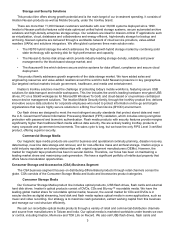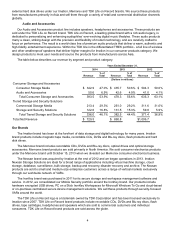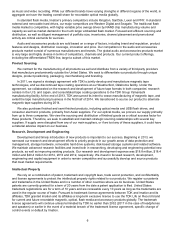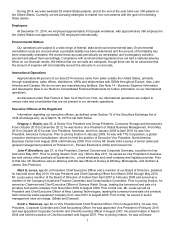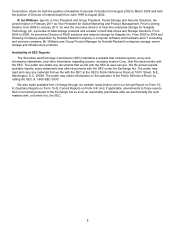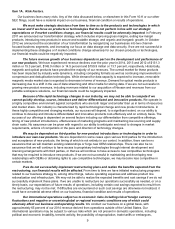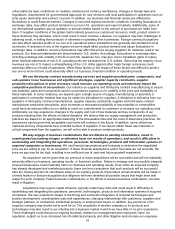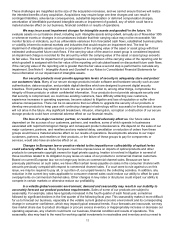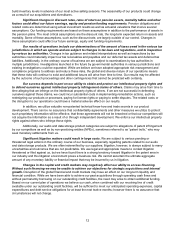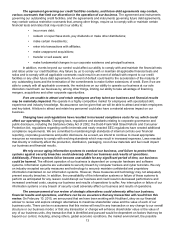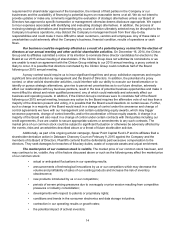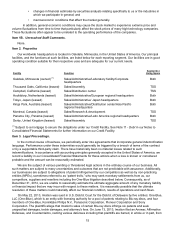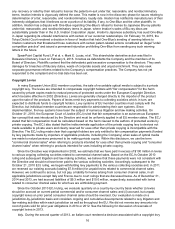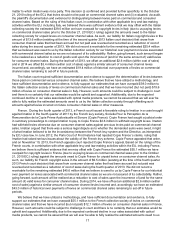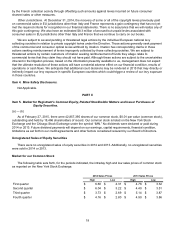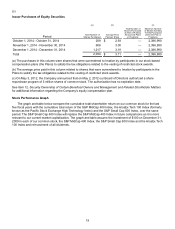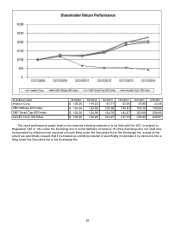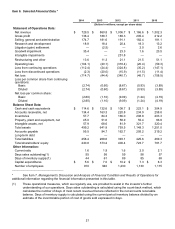Memorex 2014 Annual Report Download - page 16
Download and view the complete annual report
Please find page 16 of the 2014 Memorex annual report below. You can navigate through the pages in the report by either clicking on the pages listed below, or by using the keyword search tool below to find specific information within the annual report.11
These challenges are magnified as the size of the acquisition increases, and we cannot ensure that we will realize
the intended benefits of any acquisition. Acquisitions may require large one-time charges and can result in
contingent liabilities, adverse tax consequences, substantial depreciation or deferred compensation charges,
amortization of identifiable purchased intangible assets or impairment of goodwill, any of which could have a
material adverse effect on our business, financial condition or results of operations.
We may incur asset impairment charges for intangible assets and goodwill in the future. We
evaluate assets on our balance sheet, including such intangible assets and goodwill, annually as of November 30th
or whenever events or changes in circumstances indicate that their carrying value may not be recoverable. We
monitor factors or indicators, such as unfavorable variances from forecasted cash flows, established business plans
or volatility inherent to external markets and industries that would require an impairment test. The test for
impairment of intangible assets requires a comparison of the carrying value of the asset or asset group with their
estimated undiscounted future cash flows. If the carrying value of the asset or asset group is considered impaired,
an impairment charge is recorded for the amount by which the carrying value of the asset or asset group exceeds
its fair value. The test for impairment of goodwill requires a comparison of the carrying value of the reporting unit for
which goodwill is assigned with the fair value of the reporting unit calculated based on discounted future cash flows.
If the carrying value of the reporting unit is greater than the fair value a second step is performed to calculate any
impairment. See Note 6 - Intangible Assets and Goodwill in our Notes to Consolidated Financial Statements for
more information on our impairment of intangible assets.
Our security products must provide appropriate levels of security to adequately store and protect
our customers' data. Many of our secure storage products include software and hardware security such as user
authentication, data encryption, and portable digital identities which are designed to prevent digital security
breaches. Third parties may attempt to hack into our products in order to, among other things, compromise the
integrity of those products or obtain confidential information. If our products do not provide adequate security and
that security is compromised, we could lose existing customers, have difficulty attracting new customers,
experience increases in operating expenses, become subject to litigation and loss of reputation or suffer other
adverse consequences. There can be no assurance that our efforts to upgrade the security of our products or
develop new products to keep pace with continuing changes in technology will be successful or that product issues
will not arise in the future. Any significant breakdown, intrusion, interruption, corruption or destruction of our secure
storage products could have a material adverse effect on our financial results.
The loss of a major customer, partner, or reseller would adversely affect us. Our future sales are
dependent on the success of our customers, partners, and resellers, some of which operate in businesses
associated with rapid technological change and consequent product obsolescence. We depend on the sales of our
major customers, partners, and resellers and any material delay, cancellation or reduction of orders from these
groups would have a material adverse effect on our results of operations. Developments adverse to our major
customers, partners, and resellers or their products, or the failure of these groups to pay for components or
services, would also have an adverse effect on us.
Changes in European law or practice related to the imposition or collectability of optical levies
could adversely affect us. Many European countries impose levies on imports of optical products and other
products to compensate copyright owners for legal private copying. Imation is involved in litigation in several of
those countries related to its obligation to pay levies on sales of our products to commercial channel customers.
Based on current European law, we no longer pay levies on commercial channel sales. Because we have
previously paid levies on such sales, we have offset certain levies payable on sales in the consumer channel with
amounts previously overpaid with respect to commercial channel sales. If a court were to rule against us on this
issue, we may be required to pay all, or a portion of, our unpaid levies to the collecting societies. In addition, any
reduction in the current levy rates applicable to consumer channel sales could reduce our ability to offset for past
overpayments on commercial channel sales. Other changes in levy rates or structures could impact our ability to
compete in certain markets or otherwise reduce our profitability.
In a volatile global economic environment, demand and seasonality may result in our inability to
accurately forecast our product purchase requirements. Sales of some of our products are subject to
seasonality. For example, sales have typically increased in the fourth quarter of each fiscal year, sometimes
followed by significant declines in the first quarter of the following fiscal year. This seasonality makes it more difficult
for us to forecast our business, especially in the volatile current global economic environment and its corresponding
change in consumer confidence, which may impact typical seasonal trends. If our forecasts are inaccurate, we may
lose market share due to product shortages or procure excess inventory or inappropriately increase or decrease our
operating expenses, any of which could harm our business, financial condition and results of operations. This
seasonality also may lead to the need for working capital investments in receivables and inventory and our need to




